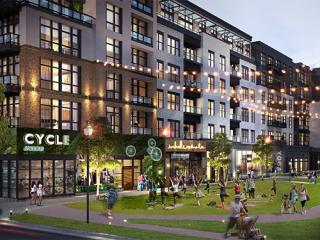Mixed-use projects: How downtowns moved to the suburbs

As the retail real estate world emerges from two years of pandemic-induced slumber, we’re coming to terms with a new and different reality, one that has reversed decades of migration to cities back to suburbs, and a new appreciation of re-using existing space. The thing is, we should have been expecting at least some of it all along.
Much had been made of the “reurbanization of America” from about 2000 on as Millennials chose to live quite differently from Baby Boomers — at least at first. “Accounting for Central Neighborhood Change, 1980 to 2010,” a study from the Federal Reserve Bank of Chicago, noted that after declining in the decades following World War II, urban populations began to grow again beginning around the turn of the century as this new generation sought the convenience, amenities, and shorter commutes of cities. Empty-nester Baby Boomers followed in search of urban excitement.
But while this was happening, close-in suburban areas were quietly densifying, adding or enhancing existing small downtown areas. Demographic Strategies for Real Estate, a 2016 report by John Burns Consulting for the Urban Land Institute (ULI), predicted that suburbs would draw about 79% of the coming wave of new households as young families sought a combination of suburban living (with larger homes and backyards) with the urban amenities they’d become accustomed to.
The pandemic upended that timeline, with professionals of all ages leaving cities for safety and extra space to accommodate working from home. And they liked it. Shorter (or no) commutes, technology that allows someone to work from anywhere, comparatively more affordable homes and the ability to knock off for an hour for a child’s event or simply to sit in the sun has many professionals rethinking their priorities.
Now, even as the pandemic subsides, many professionals want the work-life balance they achieved over the last two years. A December 2021 study from Pew Research found that just one in five (19%) of U.S. adults now express a preference for living in a city, down from about a quarter in 2018. The share of Americans who would like to live in the suburbs has increased from 42% to 46% during this time.
But after years of isolation, people still want proximity to services, the possibility of working from an office a couple of days a week, and the ability to see people in person rather than over a Zoom screen.
This dovetails with yet another situation that has been building for decades: what to do with obsolete real estate, often a shuttered department store or movie theater. The smart growth answer is to strategically reposition these older uses into suburban mixed-use projects that recreate downtown amenities yet are close to the single-family homes that Millennials now prefer.
Redeveloping sites that have existing infrastructure speeds the permitting and building process and reduces those costs. Adding new, contemporary uses revitalizes neighborhoods — local residents and other area businesses want them. And densification (within reason) accommodates a growing population and allows young professionals to stay within a community. A single person can rent an apartment, walk to work, dining and shopping, saving commuting time and costs and helping the environment. In time, that same resident could buy a home nearby as he or she begins a family.
That is why my partners Jerry Hunt, Mark Pleis, Kameron Klotz and I launched 3VG (300 Venture Group). We’ve spent our careers in adaptive reuse, mixed-use, sustainable development, placemaking and the creation of walkable projects and communities in California, a region with exceptionally high barriers to entry. And we’re doing exactly that with our first project, an underutilized property in Downtown Napa, California, less than an hour from San Francisco. Napa’s downtown has already seen a resurgence in recent years, and we plan to add to that by developing a mixed-use community with a mixture of residences, a hotel and retail, creating a mini neighborhood of its own within the city.
As with all of our redevelopment and repositioning initiatives, we’re working with city officials to determine the exact proportion, but hope to be under construction within two years, adding to the vitality of the city, and providing a healthy, lively place for Californians to call home.





